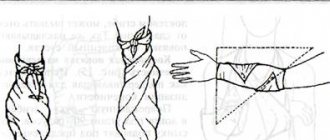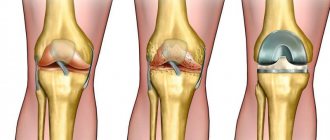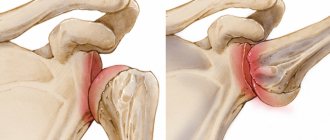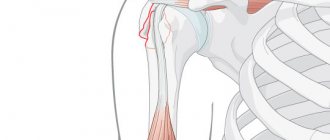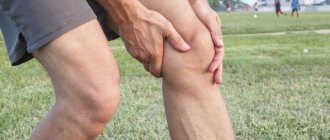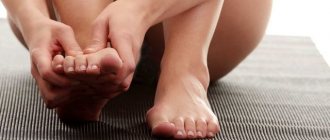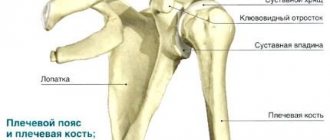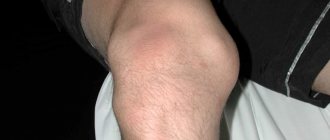The shoulder joint is a ball-and-socket joint formed by the head of the humerus and the glenoid cavity of the scapula. Like all ball and socket joints, the ligaments of the shoulder joint are sensitive to stress. According to statistics, acute shoulder injury accounts for 60% of cases in weightlifters.
Young people damage the joint when falling, overexerting themselves during sports (volleyball, basketball, strength sports), or dislocate their shoulder at work: when loading heavy objects or during repair work.
Middle-aged people (50 years and older) most often damage the joint in a fall or as a result of a bruise. The injury is aggravated by arthrosis associated with the “wear and tear” of the cartilage tissue of the joint, and the slow tissue restoration characteristic of middle age.
An elastic shoulder bandage will help prevent damage to the joint and alleviate the condition after an injury . Medical compression bandage "Intex" is a woven elastic tape made of latex, cotton and polyester fiber. When applied correctly, the bandage creates distributed pressure on the body, secures the bandages and stabilizes the joints.
Indications for applying a bandage
A bandage restricts shoulder movement after an injury.
Wrapping the shoulder with an elastic bandage helps reduce pain. It holds well without interfering with excessive movement.
You need to secure your shoulder with an elastic bandage in the following cases:
- soft tissue bruises;
- sprain of the shoulder girdle - often occurs when playing volleyball, basketball, tennis;
- exacerbation of arthritis, arthrosis of the shoulder joint;
- bursitis, tendonitis.
You should not bandage your shoulder if you have thrombophlebitis or open wounds in the damaged area.
How to properly bandage a shoulder
Shoulder bandaging scheme
Correctly applied bandage during first aid affects the effectiveness of further treatment. Bandaging is done in an upward spiral; it is important not to squeeze the vessels, but at the same time securely fix the tape so that it does not slip.
Correct dressing of the shoulder with an elastic bandage:
- Leave the edges of the elastic band at the bottom of the shoulder.
- Bandage the injured shoulder upward. Each subsequent layer should overlap the previous one by 50% of the width.
- Secure the edges with the fasteners included in the kit.
- To prevent the bandage from slipping, you need to turn the bandage over from the outside of the arm.
- With a descending bandage, the edge of the tape remains outside, bandaging begins with 2-3 circular turns. Then the bandage is pulled in a diagonal direction with moderate tension.
If the shoulder joint is damaged, wrapping begins from the armpit on the opposite side of the injured area. The tape needs to be passed over the sore shoulder joint, made a loop around it, and again returned to the starting point. Make rotations until the shoulder joint is completely closed. Secure the edges of the tape with clips.
Observation program after treatment method
Compression jersey
It is better to wash knitwear by hand (especially clothes with silicone tape), although there are products that can be washed in a machine. When washing clothes in the machine, it is recommended to place them in a wash bag to protect the fabric. Daily washing is recommended, especially if lotions or creams are used (moisturizing lotion can damage the fibers in compression garments and should only be used at night when clothing is removed). It is better to have more than one item of clothing, they should be worn alternately so that elasticity can be restored and their effectiveness can be increased. Harsh cleaning agents, solvents, and cleaners must not be used. Use mild soaps or detergents that do not contain chlorine, fabric softeners, or other laundry additives. Clothes should not be wrung out by twisting the fabric. Place it in a towel and gently wring it out. Avoid exposure to direct sunlight when drying. It's a good idea to hang your towel on a drying rack and hang your clothes on top, as the weight of the water can stretch the fabric. Compression hosiery should be replaced approximately every six months or when the garment shows signs of wear that could adversely affect its compressive properties. Generally, if a knit no longer returns to its original shape after washing or has holes in the material, it will need to be replaced.
Rules and recommendations
Elastic bandages with a width of 8.10 cm and an average length of 2 m are suitable for fixing the shoulder.
- The bandage should be strong, but not pressing.
- Bandaging is always done from left to right.
- The victim must sit. The injured limb can be supported under the elbow.
- When applying a bandage, stand facing the victim, hold the bandage in your right hand.
- Wrap the bandage and pull it evenly so that there are no folds.
An elastic bandage has many advantages. The tape can be used repeatedly; it reliably fixes the injured limb. The elastic bandage is easy to wrap and remove and is versatile.
If the bandage is applied incorrectly, blood circulation can be disrupted. The material needs to be looked after and washed promptly. Proper immobilization requires special skills and experience.
Shoulder immobilization before transport to the emergency room
In case of a shoulder injury, it is important to provide first aid to the victim correctly and in a timely manner. To do this, you need to use available materials to bandage, apply a temporary bandage, and securely fix the injured limb.
Immobilization rules:
- In case of soft tissue bruise, provide rest to the victim.
- Bend the injured limb at the elbow and place it in the middle of a wide scarf. Place the ends of the fabric behind the neck and tie with a strong knot. In this form, the victim is transported to the emergency room.
- If there are wounds, if the bleeding is not severe, rinse the damaged area with water and peroxide.
- Cover the wound with a sterile bandage.
- Apply a spiral bandage. Bandage the injured arm to the body so that it is completely motionless.
Transport immobilization will help the victim get to the hospital with minimal health consequences. After all, only in a hospital is it possible to make the correct dressing or apply a permanent plaster cast after an X-ray examination.
Briefly about the treatment method
Compression therapy in the treatment of lymphedema, using soft, low-stretch bandages and compression garments, is an integral part of disease management. The goal of compression therapy is to maintain and improve the reduction in edema achieved during treatment. Banding is the mainstay of treatment for stage 2 and 3 (moderate to severe) lymphedema and is an integral part of decongestant therapy. The advantages of the method are:
- Supports the results of lymphatic drainage massage, keeping 50% of daytime swelling.
- The bandage can be worn securely both day and night, due to the low resting pressure when the muscles are inactive and relaxed.
- The bandage is effective during training because it provides additional resistance.
- Dressing with special pads placed inside the dressing helps soften fibrous tissue.
When the active phase of therapy is over, you can move on to wearing elastic compression garments. However, it cannot be worn at night when the muscles are relaxed, so the band will need to be continued overnight. Compression sleeves and clothing are designed to help the lymph move in the right direction, maintaining the results of treatment. Compression hosiery frees the patient from constantly wearing bandages, which, thanks to the multi-layered and integrated components of the add-ons, become quite cumbersome. Single-layer support compression garments are a comfortable and effective addition to the daily life of a person with lymphedema. Another important benefit of compression garments is the medically integrated “compression gradient”. The gradient is of paramount importance for effective disease management because lymphatic fluid must be able to flow efficiently to the trunk, allowing for reduced drainage and limb reduction. To maintain normal blood and lymph circulation, the pressure should be moderately strong in the distal parts of the extremities (hand/foot) and less in the proximal areas (shoulder/thigh). While bandages create high operating pressures, compression garments create low operating pressures due to the elastic materials used in their construction. Clothing creates a very high resting pressure, while bandages create a low resting pressure, for these reasons it is not recommended for overnight use. Without the beneficial support provided by both forms of compression (clothing and bandages), treatment of lymphedema would be impossible, but together these forms of therapy achieve the desired effect (reduction of limb swelling).
Benefits of Elastic Compression
Bandage/clothing reduces the rate of ultrafiltration Lymph is a clear, protein-rich fluid in tissue spaces throughout the body. This fluid (1-2 liters per day) is usually carried by the lymphatic vessels, passes through the regional lymph nodes and joins the venous blood shortly before this blood enters the heart. Lymph circulation is important for maintaining normal tissue homeostasis throughout the body. The balance between fluid leaving the arterial side of the capillaries (ultrafiltration) on the one hand and the reabsorption that occurs in the venous capillaries as well as drainage through the lymphatic vessels on the other is known as Starling's equilibrium. Due to impaired lymphatic drainage in lymphedema, this balance is disrupted, protein-rich fluid accumulates in the tissues, colloid osmotic pressure increases, and all these events favor ultrafiltration. By raising tissue pressure using an external force (bandage or compression garment), the effective ultrafiltration pressure is reduced and less fluid accumulates, thereby improving the patient's condition. The bandage/garment improves the efficiency of muscle activity. Lymph moves through the various lymphatic vessels through muscle activity, contraction of the lymphatic vessels themselves, movements of the diaphragm (breathing) and negative pressure within the chest during the breathing cycle. In the limbs, skeletal muscle activity is an important factor in lymph transport. To maintain this process, normal tissue (skin and muscle) and joints are needed. The use of elastic compression increases the efficiency of muscle activity. The bandage/garment prevents the re-accumulation of lymphatic fluid. Manual lymphatic drainage is used to empty and decompress closed lymphatic vessels in the swollen part of the body. Since compression bandages compensate for the reduced tissue pressure of the skin, they prevent the re-accumulation of stagnant lymphatic fluid and thereby maintain the treatment result.
Shoulder girdle taping
Methods for taping the shoulder joint
Tape is an adhesive tape made of fabric that is used to fix or support the joint. Advantages: convenient to use, not visible under clothes, does not lose its properties when swimming. Taping improves blood circulation and increases lymph flow. Elastic kinesio tape provides soft immobilization, which speeds up the regeneration process.
Taping rules and scheme:
- Cleanse the skin of sweat and dirt, remove hair if necessary.
- Wipe the skin with an alcohol-containing solution.
- Measure the required length of tape and round off the ends.
- If the deltoid muscle is damaged, the tape is applied in the shape of the letter Y. The tape is applied without tension at the site of attachment of the muscle to the humerus. The rays of the tape extend to the anterior and posterior bundles.
- In case of injuries to the periosteal brachialis muscle, the tape is glued to the area of the junction of the shoulder bone and clavicle. The first 2-3 cm of the tape should be without tension, then it should be stretched to the middle part and above the spine of the scapula by 25-30%. The tape should be positioned perpendicular to the spine.
- To secure all muscle and tendon fibers, you need to use a wide tape. Cut 30-40 cm, stick over the shoulder joint.
Taping is carried out in case of dislocation of the shoulder joint without displacement, bursitis, to prevent exacerbation of chronic injuries. For acute injuries, tape can be applied after swelling has resolved.
Why do a dressing?
The procedure is multidisciplinary; it simultaneously pursues several goals. All of them will be discussed in more detail below:
- Protection. Wounds need to be protected from dirt and dust. Only in conditions as close to sterile as possible will they heal truly quickly.
- Disinfection. Every day (and sometimes several times a day), changing the dressings in the dressing rooms, the medical staff treats the wound with antiseptic compounds, which minimizes the occurrence of infections, suppuration and other pathological processes
- Fixation of medications. Ointments and gels, due to their consistency, cannot adhere to the surface of the wound on their own, so they urgently need reliable fixation. This is ensured by bandaging
Specialists in dressing rooms solve one of the above problems or all at once. This process is an integral part of the postoperative period, in cases where surgical intervention has taken place.
Shoulder scarf
Kerchief bandage
Kerchief bandage is a method of emergency fixation, used immediately after an injury. The bandage reduces the risk of subsequent damage to the shoulder, prevents rupture of blood vessels, the formation of hematomas and edema. This is a triangular piece of tissue that immobilizes the injured limb.
How to wrap your shoulder with a scarf:
- Place the tip of the fabric cut in the armpit.
- Cross the ends over the shoulder and draw on both sides of the chest.
- Tie a knot in the area of the opposite armpit.
- If everything is done correctly, the upper limb will be completely immobilized, since it is tightly pressed to the body.
A scarf bandage is applied in case of dislocation and injury of the shoulder, or suspected damage to the collarbone. This is one of the easiest ways to quickly re-wrap a shoulder after a dislocation or sprain.
Prognosis after treatment method
Although lymphedema can be reduced to normal or near-normal size with proper treatment, the lymphatic vessels never become normal again. In addition, after swelling decreases, skin elasticity is not completely restored. Therefore, external support is an important component in the treatment of the disease. Even after successful treatment, the part of the body affected by lymphedema is at constant risk of fluid accumulation again, and most people with lymphedema know that this condition requires lifelong care. Without the benefits of external compression, successful long-term disease management would be very difficult and in most cases impossible.
Rigid immobilization
Rigid fixation orthoses are used for complete immobilization. The design consists of a metal frame, equipped with volume and angle of movement regulators. Use only as prescribed by a doctor. Indications: humeral neck fracture, ligament damage, collarbone injury.
Every person needs to know the rules of first aid and bandaging. Injuries can happen at any time. Athletes, sports doctors and coaches need to master various bandaging techniques.
